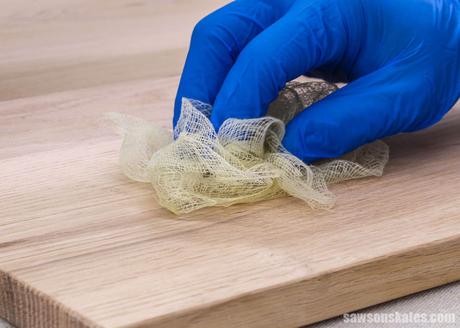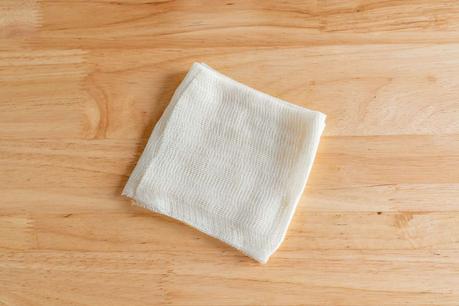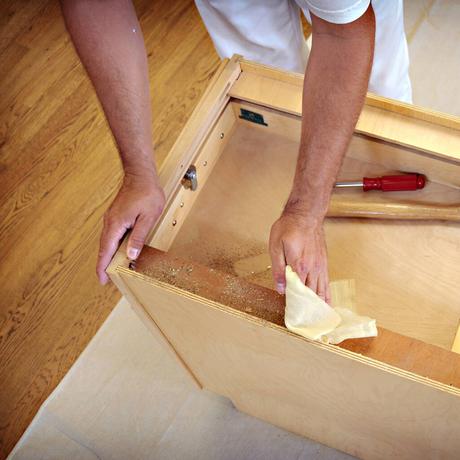A tack cloth is a sticky cloth used for removing dust and debris from surfaces before painting or finishing. Preparing surfaces for painting or finishing requires removing any dust or particles that could affect the smoothness of the final product.
This is where a tack cloth comes in handy. A tack cloth is a specialized cloth treated with a sticky substance. When used, it attracts and traps dust and other particles, leaving the surface clean and ready for painting or finishing.
It is commonly used in woodworking, metalworking, automotive refinishing, and other industries where a clean surface is crucial. The sticky nature of a tack cloth ensures that it effectively picks up even the smallest particles, providing a smooth and flawless finish.

Credit: sawsonskates.com
Definition Of A Tack Cloth
A tack cloth, also known as a tack rag, is a specialized cleaning cloth used in various industries, including automotive and woodworking. It is typically made of fabric coated with a sticky substance that removes dust, lint, and other particles from surfaces before painting or finishing.
What Is A Tack Cloth?
A tack cloth, also known as a tack rag, is a specialized cleaning cloth that is used in various industries, particularly in the automotive, woodworking, and construction sectors. It is made from a thin, gauze-like fabric that is slightly sticky to the touch, which allows it to effectively remove dust, dirt, and other particles from surfaces.
Purpose Of A Tack Cloth
The tack cloth serves a crucial purpose in the preparation process before painting, varnishing, or applying any finishes to a surface. Its main function is to remove any loose particles that might interfere with the final coating, ensuring a smooth and professional finish.
Here’s a breakdown of the purposes of a tack cloth:
- Capture Dust and Debris: The sticky nature of the tack cloth enables it to capture and hold fine particles, including dust, lint, and sanding residue, effectively preventing them from settling back onto the surface.
- Promote Adhesion: By removing loose particles, the tack cloth allows for better adhesion between the surface and the paint or finish, resulting in a more durable and long-lasting coating.
- Prevent Contamination: Contaminants such as oils, waxes, and silicone can compromise the quality of the finish. Using a tack cloth helps remove these substances, ensuring a clean and uncontaminated surface.
- Save Time and Effort: The tack cloth is designed to be efficient and easy to use. Its sticky nature makes it effective at quickly picking up particles without leaving any residue behind, saving time and effort in the preparation process.
It is important to note that tack cloths are typically designed for single-use only. This is to prevent the transfer of particles from one surface to another, which could potentially affect the finish.
Overall, the tack cloth is an indispensable tool for achieving a professional and flawless finish in various industries. Its ability to capture dust and debris, promote adhesion, prevent contamination, and save time makes it an essential part of the preparation process.

Credit: www.thespruce.com
Composition And Construction
In understanding what a tack cloth is, it is essential to explore its composition and construction. A tack cloth, also known as a tack rag, is a specialized cleaning cloth used in various industries, including woodworking, automotive, and painting. Its unique design and materials make it an indispensable tool for achieving smooth, flawless surfaces. Let’s dive into the materials used in tack cloth and the manufacturing process that brings them together.
Materials Used In Tack Cloth
The materials used in the production of a tack cloth play a crucial role in its effectiveness. Manufacturers carefully select specific materials to ensure optimal functionality. The primary components of a tack cloth include:
- Lint-Free Fabric: The base of a tack cloth is typically made of lint-free cotton or synthetic material. This fabric is meticulously chosen to avoid leaving any traces of lint or fibers on the surface being cleaned.
- Tackifying Solution: To give the cloth its sticky and adhesive properties, a tackifying solution is applied to the fabric. This solution, usually a resin or glue, effectively traps and holds particles, minimizing the risk of contamination during the cleaning process.
- Anti-Static Additives: To prevent the build-up of static electricity, which can attract dust and particles, tack cloths may contain anti-static additives. These additives improve the safe handling of the cloth by reducing the risk of electrostatic discharge.
Manufacturing Process Of Tack Cloths
The manufacturing process of tack cloths is carefully executed to ensure consistency and quality. While specific techniques may vary among manufacturers, the general steps in the production process include:
- Fabric Selection: High-quality lint-free fabric is chosen for the base of the tack cloth. The fabric is selected based on its absorbency, durability, and ability to hold the tackifying solution.
- Tackifying Solution Application: The selected fabric is then treated with the tackifying solution. This step involves applying the solution evenly across the fabric’s surface, ensuring it permeates the fibers. The appropriate amount of solution is crucial to achieve the desired level of tackiness without leaving residue.
- Drying and Cutting: After the tackifying solution is applied, the fabric is allowed to dry thoroughly. Once completely dry, the fabric is cut into the desired sizes, typically into manageable pieces or rolls for ease of use.
- Packaging: The final step in the manufacturing process involves packaging the tack cloths. They are carefully sealed in airtight material to maintain their sticky properties and prevent contamination before use.
Tack cloths consist of lint-free fabric treated with a tackifying solution to create a sticky, adhesive surface. The materials used in tack cloth construction, including the fabric, tackifying solution, and anti-static additives, are carefully selected to ensure effective performance. The manufacturing process involves fabric selection, application of the tackifying solution, drying and cutting, and finally, packaging. This attention to detail and quality control ensures that tack cloths are reliable tools for achieving smooth and flawless surfaces in a wide range of applications.
Benefits Of Using A Tack Cloth
When it comes to achieving a flawless finish on any surface, using a tack cloth can make all the difference. This versatile tool has become a staple in the arsenal of professional painters and DIY enthusiasts alike. In this section, we will explore the various benefits of using a tack cloth for your painting projects. From removing dust and debris to preventing contamination and improving paint adhesion, a tack cloth is an essential tool that can enhance the quality and longevity of your paint job.
Removes Dust And Debris
A tack cloth’s primary function is to remove dust and debris from surfaces before painting. Dust particles and lint can easily settle on surfaces, especially if they have been left exposed for some time. When it comes to painting, these tiny particles can pose a significant problem, as they can mar the smoothness of the finish and create imperfections. However, with a tack cloth, you can effortlessly remove all these unwanted elements in a matter of seconds.
Prevents Contamination
In addition to removing dust and debris, a tack cloth also acts as a barrier against contamination. During the painting process, it is crucial to ensure that no foreign substances, such as oil, grease, or wax, come in contact with the surface. These contaminants can adversely affect the adhesion of the paint and result in an uneven finish. By using a tack cloth, you can effectively eliminate any potential sources of contamination and create a clean, paint-ready surface.
Improves Paint Adhesion
One of the key benefits of using a tack cloth is its ability to improve paint adhesion. The sticky nature of the cloth ensures that it not only removes dust and debris but also captures and holds onto any loose particles that may have been missed during the initial cleaning. This helps to create a perfectly clean surface, free from any lingering particles that could interfere with the paint adhesion. With better adhesion, the paint is less likely to peel or chip, resulting in a longer-lasting and more professional-looking finish.
A tack cloth is an invaluable tool for any painting project. Its benefits extend beyond simply removing dust and debris, as it also serves to prevent contamination and improve paint adhesion. By using a tack cloth, you can achieve a smoother and more durable paint finish, ensuring your project looks impeccable for years to come.
Types Of Tack Cloths
When it comes to achieving a flawless finish in your painting or varnishing project, using a tack cloth can make all the difference. But what exactly is a tack cloth, and which type is right for your needs? In this article, we will explore the three main types of tack cloths available: woven tack cloths, non-woven tack cloths, and microfiber tack cloths.
Woven Tack Cloths
Woven tack cloths are one of the oldest and most popular types of tack cloths. They are made by weaving threads together, typically cotton or a blend of materials, to create a durable and tacky cloth. This type of tack cloth is ideal for removing larger particles, such as dust, wood chips, and metal shavings, from the surface before painting or varnishing. The tackiness of the cloth helps to trap these particles, ensuring a clean and smooth surface for your finishing work.
Non-woven Tack Cloths
Non-woven tack cloths, as the name suggests, are made without the traditional weaving process. Instead, fibers are bonded together through a heat or chemical process, creating a cloth with a slightly tacky surface. This type of tack cloth is known for its excellent particle removal capabilities, as the non-woven fibers can effectively trap even the smallest dust particles and lint. Non-woven tack cloths are perfect for preparing surfaces that require a high level of cleanliness, such as automotive refinishing or precision woodworking.
Microfiber Tack Cloths
Microfiber tack cloths have gained popularity in recent years due to their superior cleaning and absorption properties. Made from ultra-fine synthetic fibers, microfiber tack cloths are exceptionally soft and gentle on surfaces, making them suitable for delicate finishes. These cloths excel at picking up fine dust and smudges, leaving the surface smooth and ready for painting or varnishing. Microfiber tack cloths are a great choice for projects that require a lint-free and scratch-free surface, such as painting furniture or applying clear coats.
Choosing the right type of tack cloth can greatly impact the final outcome of your painting or varnishing project. Whether you opt for a woven tack cloth, non-woven tack cloth, or microfiber tack cloth, each type offers its own unique benefits and is suited for different applications. By understanding these types and their characteristics, you can ensure a flawless finish every time.
Tips For Using A Tack Cloth
A tack cloth is a crucial tool in any DIY or professional painting project. It is designed to pick up and remove fine particles of dust, dirt, and debris from the surface, ensuring a clean and smooth finish. To achieve the best results, it’s important to use a tack cloth properly and handle/store it correctly. Here are some tips to help you make the most out of your tack cloth:
Proper Technique For Tack Cloth Usage
When using a tack cloth, it’s essential to follow the proper technique to ensure effective cleaning and avoid damaging the surface. Here’s how to use a tack cloth correctly:
- Before starting, ensure that the tack cloth is clean and free from any loose fibers or debris.
- Hold the tack cloth lightly and unfold it fully.
- Gently wipe the cloth in straight lines, applying light pressure. Avoid excessive rubbing or scrubbing, as this can leave behind adhesive residue on the surface.
- As the cloth becomes dirty or filled with particles, refold it to reveal a clean section and continue wiping until the entire surface is clean.
- Do not reuse a tack cloth that has been dropped on the floor or heavily soiled, as it may transfer dirt onto the surface.
Storage And Handling Of Tack Cloths
Proper storage and handling of tack cloths are essential to preserve their adhesive properties and ensure their effectiveness. Follow these guidelines:
- Store tack cloths in a sealed plastic bag or container to prevent them from drying out or picking up dust when not in use.
- Avoid exposing tack cloths to excessive heat or direct sunlight, as this can cause them to lose their tackiness.
- Handle tack cloths with clean hands to prevent transferring oils or dirt onto the cloth.
- Dispose of used tack cloths properly, as they may be flammable due to their adhesive coating. Check local regulations for the correct disposal method.
By following these tips, you can maximize the effectiveness of your tack cloth and achieve a clean, professional finish in your painting projects. Remember to use the proper technique for wiping and store/handle your tack cloths correctly to maintain their quality and performance.

Credit: trimaco.com
Frequently Asked Questions On What Is A Tack Cloth?
What Can I Use Instead Of Tack Cloth?
Microfiber cloth is an effective alternative to tack cloth. It removes dust and debris before painting or staining, providing a smooth finish. Microfiber cloth is reusable, easy to find, and offers superior lint-free results for your DIY projects.
What Is Tack Cloth Used For?
Tack cloth is used for removing dust and particles from surfaces before painting or finishing. It is sticky and traps debris effectively.
Can I Use A Damp Cloth Instead Of A Tack Cloth?
A damp cloth can be used as an alternative to a tack cloth for removing dust and debris before painting or finishing. However, it may not be as effective in picking up fine particles, so a tack cloth is recommended for better results.
Is Tack Cloth And Cheesecloth The Same Thing?
No, tack cloth and cheesecloth are not the same. Tack cloth is a sticky cloth used to remove dirt and debris from surfaces before painting or finishing, while cheesecloth is a loose, gauze-like fabric used for straining liquids or wrapping foods.
What Is A Tack Cloth Used For?
A tack cloth is used to remove dust, dirt, and debris from surfaces before painting or varnishing, ensuring a smooth and clean finish.
Conclusion
To sum up, a tack cloth is an essential tool for achieving a smooth and flawless finish in various painting and woodworking projects. Its sticky surface efficiently captures dust, debris, and other particles that could ruin the final result. By using a tack cloth, you can ensure a professional and polished outcome that will leave a lasting impression.
So, next time you embark on a painting or woodworking project, don’t forget to add a tack cloth to your toolkit.
